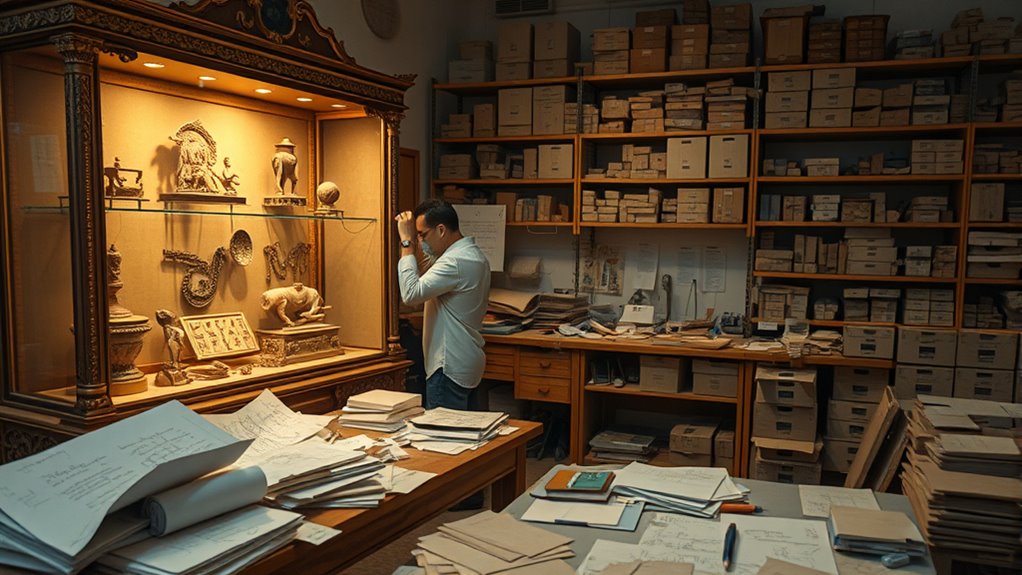Behind the scenes, curating museum exhibitions involves research, selecting artifacts, and ensuring their preservation. You’ll coordinate with experts like historians and scientists to develop a compelling story. A lot of attention goes into designing the layout, integrating interactive displays, and carefully controlling lighting and climate for artifact safety. Every detail aims to create an engaging, educational experience for visitors. If you keep exploring, you’ll discover even more about the fascinating process of bringing exhibitions to life.
Key Takeaways
- Curators conduct research and select artifacts that align with the exhibition’s theme and educational goals.
- They collaborate with specialists to assess artifact condition and plan conservation treatments.
- The layout design balances aesthetic appeal, storytelling, and visitor engagement through careful planning.
- Interactive displays and multimedia elements are integrated to enhance the visitor experience and understanding.
- Behind the scenes, meticulous preservation techniques and climate controls safeguard fragile artifacts during display and storage.

Exhibitions in museums offer a dynamic way to explore art, history, science, and culture all in one place. As a visitor, you might be amazed at how these displays come together to create immersive experiences. Behind the scenes, curators and staff work tirelessly to select, arrange, and present artifacts and artworks, guaranteeing each exhibit tells a compelling story. One of the key elements in modern exhibitions is the use of interactive displays, which invite you to engage directly with the content. These displays transform passive viewing into active participation, whether through touch screens, virtual reality, or hands-on activities. They make the learning process more engaging and memorable, especially when you get to handle replicas or explore digital reconstructions.
Interactive displays in museums turn passive viewing into engaging, hands-on learning experiences.
But before any exhibit opens to the public, a significant focus is placed on artifact preservation. Museum professionals understand that many items are fragile and require careful handling and climate control to prevent deterioration. This means employing specialized techniques like controlled lighting, humidity regulation, and secure mounts to keep artifacts safe, while still allowing you to experience their significance firsthand. Preservation isn’t just about keeping objects intact; it’s about maintaining their historical and cultural integrity so future generations can appreciate them as well. Incorporating attention to detail during the curation process ensures that each element contributes to a cohesive and meaningful narrative.
The process of curating an exhibition begins long before you set foot in the gallery. Curators research and select items that align with the intended theme, often collaborating with historians, scientists, or artists to gather the most relevant pieces. Once the artifacts are acquired, they undergo condition assessments and conservation treatments to ensure they’re stable enough for display. The layout of the exhibition is then meticulously planned, balancing aesthetic appeal with educational flow. Here, interactive displays are integrated thoughtfully, enhancing storytelling without overwhelming the core artifacts. Additionally, understanding artifact preservation techniques helps ensure that these objects remain accessible and meaningful for future generations. Every element is carefully orchestrated to guarantee that when you step into an exhibition, you’re not just looking at objects—you’re experiencing history, art, or science in a way that’s meaningful and memorable. It’s a complex, carefully orchestrated process that transforms simple displays into powerful educational tools.
Frequently Asked Questions
How Are Exhibition Themes Initially Chosen?
When choosing exhibition themes, you start by considering current trends, audience interests, and the museum’s mission. You then develop exhibition branding that resonates with visitors and aligns with promotional strategies to generate buzz. You analyze past successes and gather input from curators and stakeholders. This collaborative process guarantees the theme appeals widely, creating a compelling experience that encourages attendance and engagement, setting the stage for a memorable exhibition.
What Criteria Determine Artifact Selection?
When selecting artifacts, you consider their provenance to guarantee authenticity and significance. You also evaluate if they meet conservation standards, ensuring they’re preserved properly for display. You aim for a balanced collection that tells a compelling story, so you prioritize items with clear history and good condition. Ultimately, your choices reflect both the narrative you want to share and the museum’s ability to care for the artifacts long-term.
How Do Curators Collaborate With Artists and Lenders?
You work closely with artists and lenders through artistic negotiations and detailed loan agreements. You discuss the artwork’s significance, display requirements, and conservation needs, ensuring everyone’s expectations align. You negotiate the terms of the loan, including duration and insurance, to safeguard the pieces. This collaboration helps create a cohesive exhibition that respects the artists’ intentions and meets the museum’s standards, resulting in a successful, engaging display.
What Is the Timeline for Planning an Exhibition?
You’d think planning an exhibition is quick, but it’s a meticulous dance that takes months. You set your timeline early, juggling exhibition marketing and budget planning to guarantee everything aligns. From initial concept to opening, you coordinate with artists, lenders, and staff, all while keeping deadlines tight. Patience is key, because rushing can turn your carefully curated vision into a chaotic scramble, ruining the magic before it even begins.
How Are Visitor Feedback and Engagement Incorporated?
You actively seek visitor feedback and engagement by incorporating interactive displays and digital integration into exhibitions. As a visitor, your opinions help shape the experience, encouraging museums to add touchscreens, QR codes, or augmented reality features. These tools make your visit more engaging and personalized, ensuring the exhibits resonate with diverse audiences. Your input directly influences future enhancements, creating a dynamic, memorable museum experience tailored to your interests.
Conclusion
As you step into a museum, imagine you’re entering a carefully crafted storybook. Just like a skilled storyteller, curators weave together artifacts, themes, and narratives to captivate visitors. Did you know that over 70% of visitors say exhibitions influence their understanding of history? Behind the scenes, every detail is meticulously planned—akin to a chef perfecting a recipe—ensuring your experience is both enlightening and memorable. So next time, appreciate the magic behind each display.









